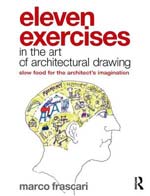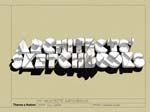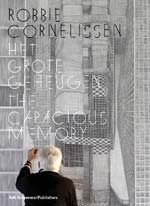
|

|
|
Home Site Search Contact Us Subscribe
|
|
|
Book Review: Pencils that Refuse to Die: Meditations about New Books on Architectural Drawing Three recent books dealing with architectural drawing by pencil you need to read: "Eleven Exercises in the Art of Architectural Drawing: Slow Food for the Architect's Imagination" by Marco Frascari; "The Architect's Sketchbook" by Will Jones; and "Robbie Cornelissen: The Capacious Memory" by Lex ter Braak and Edwin Jacobs By Norman Weinstein September 23, 2011 There’s an anecdote about the composer Arnold Schoenberg whose first music composition class at UCLA opened by his holding a pencil like a defiantly upright sword before bewildered students in a lecture hall. “This is the pencil’s point,” he said, his finger tapping its graphite tip. “This is the eraser,” he added, cursively caressing its soft crown. Then he paused. Again he traced the eraser’s surface. “The eraser is the more important part. This class is now dismissed.” The Schoenberg anecdote might seem quaint (if not irrelevant) to architectural drawing in the age of the computer’s “delete” key. Perhaps this pointless opening paragraph needs sharpening, and exists just as a leaden, overdrawn attempt to re-inscribe Luddite thinking, tangled intellectual scribble?
But my opening is a ruse. Encoded in my telling of the Schoenberg anecdote are words conveying pencil imagery beyond the Schoenberg moment: “Leaden.” “Cursively” (as in “cursive”). “Sharpening.” The point? Three recent books dealing with architectural drawing by pencil are sitting on my desk. And I’m insisting you need to read and study them, and then put ideas from them into practice. These publications are proof positive that despite the omnipresence of AutoCAD and BIM, pencils refuse to die! Of course pencils have never literally died as much as been reduced to wood shavings and graphite dust – but the conceptual primacy of the pencil as an irreplaceable tool for architectural thinking and drafting is just about expired. Who can doubt the rightness of Stewart Brand’s quip: “Once a new technology rolls over you, if you’re not part of the steamroller, you’re part of the road.”
Sorry, Stewart. I’m not part of a steamroller or road today. I’m holding a No. 2 pencil and underlining passages in my non-e-book, Eleven Exercises in the Art of Architectural Drawing: Slow Food for the Architect’s Imagination by Marco Frascari (Routledge, 2011). An e-book version can be ordered through Amazon, but be forewarned. The author’s delightfully funky and baroquely quirky illustrations so central to his book may likely look incoherent on an electronic reader’s compact screen. Frascari’s text is a challenging workbook, a set of deep lessons in architectural drawing unlikely to be found in any conventional architecture school. And while you’ll want to keep a set of drafting pencils nearby as you work your way through the text, you’ll also find some of his 11 exercises will require pens and brushes. And here is an exercise that requires inventing your own marker:
Make your own marking tools (pencils and pens that have been produced industrially are not allowed), for instance, it is possible to use drinking straws or stirrers cut into quill pens.
Make your edges for drawing lines: they do not need to be straight but rather they should be related to your design intention; the same condition should be followed in the facture of the necessary squares. . .
The object of this and 10 other exercises is to offer “slow food for the architect’s imagination.”
Unlike a mouse or touch screen, tools that accelerate the visual symbolization of architectural thinking, Frascari builds a well developed case for decelerating the movement from thought to image on a monitor or printout. Additionally, very like the thinking of Juhani Pallasmaa in The Eyes of the Skin: Architecture and the Senses, Frascari believes truly inventive design entails an intense multisensory immersion, a synesthetic state, during the drafting process. As Frascari notes:
During cooking or drawing processes, one of the human senses is considered dominant, but the result as well as the making – a dish or a building – ought to be conceived and appreciated with the totality of senses. By looking to the color of the food during the cooking process a chef will evoke if it is ready or not, and in the case of architecture by a color pencil delineation of a room, can evoke its thermal or acoustic delights.
Factor out any delicately refined sense of touch while designing – which is exactly what we do when numbly punching a keyboard or clicking a mouse – and the result will be a design less than touching (pun intended). The slowness inherent to the pencil as drafting tool offers the opportunity, the time expanse and tactile experience, nervous finger pressure against wood driving point home, to bring multisensory perception to the forefront of imagination. And with that multisensory perspective during pencil drawing comes a sense of human imperfection realized in “built solid stuff” Frascari differentiates from the “dream stuff” created by CAD, BIM, and other varieties of digital modeling. Frascari daringly suggest ways of inappropriately using CAD and BIM to create bold designs, a revolutionary suggestion he wryly downplays by noting how often architecture students misuse discarded doors as drafting tables, functional misappropriation of unloved things a commonplace in design schools.
This is an architectural workbook designed as a set of shocking provocations. The exercises are framed by dense philosophical arguments written in a knotty style that demands very slow and thorough reading. The rewards for using this dense book appear overwhelming and timely, given the uncritical overwhelming pressure, now reinforced by academic dogma and rapacious tech software marketing tactics, to generally avoid pencils whenever digital drafting tools abound.
A delightful substantiation of Frascari’s ideas arrives in an anthology of sketches by 85 architects collected by Will Jones in The Architect’s Sketchbook (Metropolis Books, 2011). Here’s eye-candy as brain-candy; coffee-table book as a door into creative playground graffiti of a serious order. From the crazed comic designs conceived by M15 Arquitectos to the unnervingly precise and photo-realistic pencil drawings of interiors of Peter Clash, there’s more invention and more humanism, more room for enticing puzzling, in these informal sketches than you’ll find on a bookshelf of glossy architectural journals filled with BIM bling. A book for all ages, for professionals and the merely curious.
The same can be said for a new book by Lex ter Braak and Edwin Jacobs, Robbie Cornelissen: The Capacious Memory (NAi Publishers, 2011). It is a stunning portfolio of drawings by Cornelissen, a leading contemporary Dutch draughtsman, of uninhabited architecture that mingle the unsettling geometries of M.C. Escher’s structures with the depopulated landscapes of the Surrealist painter Yves Tanguy. They confound our usual notions of how architectural interiors and exteriors relate, and scramble any sense of human scale while not abandoning the sense that these spaces are designed for future habitation. Several drawings suggest library interiors where the ghosts of authors play hide-and-go-seek behind their bound volumes. Like the Jones anthology, Cornelissen’s book is a wild incubator for architectural imagination “outside the box.” These are pencil drawings created to fill large gallery walls, tour de forces of a steady hand and steely imagination. Very slow food for any architect’s imagination – and pleasing to the senses. Worthy of long savoring.
Norman Weinstein writes about architecture and design for Architectural Record, and is the author of “Words That Build” – an exclusive 21-part series published by ArchNewsNow.com – that focuses on the overlooked foundations of architecture: oral and written communication. He consults with architects and engineers interested in communicating more profitably; his webinars are available from ExecSense. He can be reached at nweinstein@q.com.
More by Weinstein:
A Meditation on the Beauty of Zaha Hadid's Door Handle Hadid's design issues a challenge: define beauty by lyrically playing with illusion.
Why "Greatest
Hits" Lists by Architecture's Stars Should Be Mocked
Celebratory Meditations on SANAA Winning the Pritzker Prize
Op-Ed: Life After Ada: Reassessing the Utility of
Architectural Criticism
Book Review:
"One Million Acres & No Zoning": Lars Lerup's Outrageous Encomium
to Houston Instructs and Infuriates
Book Review: Talkin'
'Bout (Not) My Generation: Uplifting Gen X Architects Showcase Pragmatic
Optimism
"Frank Lloyd
Wright's Guggenheim Museum": Bravura Example of an Architectural
Documentary - Wright's Guggenheim Done Right
Book Review: Diving
into Architecture from Every New Angle: Reading Guillevic's
"Geometries"
Book Review:
"Immaterial World: Transparency in Architecture": Marc Kristal
crystallizes increasingly complex notions of transparency with a light touch.
Book Review:
"Visual Planning and the Picuresque" by Nikolaus Pevsner. Edited by
Mathew Aitchison
Book Review: How New
Urbanism's Case Triumphs Best Through "The Language of Towns & Cities:
A Visual Dictionary" by Dhiru A. Thadani
Best Architecture
Books of 2010
Book
Review: "Architecture and Beauty: Conversations with Architects about a
Troubled Relationship": Yael Reisner exuberantly interviews architects
about beauty
Book Review: Shedding
Light on Concrete: Tadao Ando: Complete Works 1975-2010 by Philip Jodidio
Book Review: Sage
Architectural Reflections from Architecture's "Athena": Denise Scott
Brown's "Having Words" distills a lifetime of theorizing and practice
into practical and succinct guidance for thriving through difficult times
Book Review: Keeping
the Architectural Profession Professional: "Architecture from the Outside
In: Selected Essays by Robert Gutman" celebrates Gutman's legacy as
invaluable outsider
Book Review:
"Design through Dialogue: A Guide for Clients and Architects," by
Karen A. Franck and Teresa von Sommaruga Howard
Twilight Visions: Vintage Surrealist Photography Sheds
New Light on Architecture
Best
Architecture Books of 2009
Book Review: "Gunnar Birkerts: Metaphoric Modernist" by Sven Birkerts and Martin Schwartz A major architect in the history of Modernism finally receives recognition – and sundry asides about why Modernism never exited.
Book Review:
"Urban Design for an Urban Century: Placemaking for People," by Lance
Jay Brown, David Dixon, and Oliver Gillham
Book Review:
"Everything Must Move: 15 Years at Rice School of Architecture
1994-2009"
Book Review: A Subversive Book Every Architect Needs:
"Architect's Essentials of Negotiation" by Ava J. Abramowitz
Book Review: A Perspective from One Elevation: "Conversations With Frank Gehry" by Barbara Isenberg Gehry's conversations offer portraits of an astute listener as well as talker, an architect as aware of his flaws and limitations as of his virtues.
Best Architecture Books of 2008
Book Review: You've Got to Draw the Line Somewhere A review of Drafting Culture: a Social History of Architectural Graphic Standards by George Barnett Johnston
Book Review: "NeoHooDoo: Art for a Forgotten Faith," edited by Franklin Sirmans Sharpen your pencils - and get ready to do a NeoHooDoo shimmy.
|
(click on pictures to enlarge) 


|
© 2011 ArchNewsNow.com